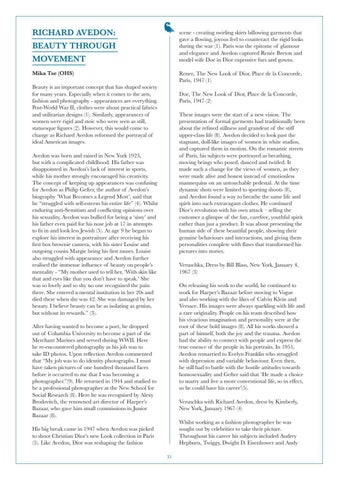RICHARD AVEDON:
scene - creating swirling skirts billowing garments that gave a flowing, joyous feel to counteract the rigid looks during the war (1). Paris was the epitome of glamour and elegance and Avedon captured Renée Breton and model wife Doe in Dior expensive furs and gowns.
BEAUTY THROUGH MOVEMENT Mika Tse (OHS)
Renee, The New Look of Dior, Place de la Concorde, Paris, 1947 (1)
Beauty is an important concept that has shaped society for many years. Especially when it comes to the arts, fashion and photography - appearances are everything. Post-World War II, clothes were about practical fabrics and utilitarian designs (1). Similarly, appearances of women were rigid and stoic who were seen as still, statuesque figures (2). However, this would come to change as Richard Avedon reformed the portrayal of ideal American images.
Doe, The New Look of Dior, Place de la Concorde, Paris, 1947 (2) These images were the start of a new vision. The presentation of formal garments had traditionally been about the refined stillness and grandeur of the stiff upper-class life (8). Avedon decided to look past the stagnant, doll-like images of women in white studios, and captured them in motion. On the romantic streets of Paris, his subjects were portrayed as breathing, moving beings who posed, danced and twirled. It made such a change for the views of women, as they were made alive and honest instead of emotionless mannequins on an untouchable pedestal. At the time dynamic shots were limited to sporting shoots (8), and Avedon found a way to breathe the same life and spirit into such extravagant clothes. He continued Dior’s revolution with his own attack – selling the customer a glimpse of the fun, carefree, youthful spirit rather than just a product. It was about presenting the human side of these beautiful people, showing their genuine behaviours and interactions, and giving them personalities complete with flaws that transformed his pictures into stories.
Avedon was born and raised in New York 1923, but with a complicated childhood. His father was disappointed in Avedon’s lack of interest in sports, while his mother strongly encouraged his creativity. The concept of keeping up appearances was confusing for Avedon as Philip Gefter, the author of Avedon’s biography ‘What Becomes a Legend Most’, said that he “struggled with self-esteem his entire life” (4). Whilst enduring anti-Semitism and conflicting opinions over his sexuality, Avedon was bullied for being a ‘sissy’ and his father even paid for his nose job at 17 in attempts to fit in and look less Jewish (5). At age 9 he began to explore his interest in portraiture after receiving his first box brownie camera, with his sister Louise and outgoing cousin Margie being his first muses. Louise also struggled with appearance and Avedon further realised the immense influence of beauty on people’s mentality - “My mother used to tell her, ‘With skin like that and eyes like that you don’t have to speak.’ She was so lovely and so shy no one recognized the pain there. She entered a mental institution in her 20s and died there when she was 42. She was damaged by her beauty. I believe beauty can be as isolating as genius, but without its rewards.” (3).
Veruschka, Dress by Bill Blass, New York, January 4, 1967 (3) On releasing his work to the world, he continued to work for Harper’s Bazaar before moving to Vogue and also working with the likes of Calvin Klein and Versace. His images were always sparkling with life and a rare originality. People on his team described how his vivacious imagination and personality were at the root of these bold images (8). All his works showed a part of himself, both the joy and the trauma. Avedon had the ability to connect with people and express the true essence of the people in his portraits. In 1951, Avedon remarried to Evelyn Franklin who struggled with depression and variable behaviour. Even then, he still had to battle with the hostile attitudes towards homosexuality and Gefter said that ‘He made a choice to marry and live a more conventional life, so in effect, so he could have his career’(5).
After having wanted to become a poet, he dropped out of Columbia University to become a part of the Merchant Marines and served during WWII. Here he re-encountered photography as his job was to take ID photos. Upon reflection Avedon commented that “My job was to do identity photographs. I must have taken pictures of one hundred thousand faces before it occurred to me that I was becoming a photographer.”(9). He returned in 1944 and studied to be a professional photographer at the New School for Social Research (8). Here he was recognised by Alexy Brodovitch, the renowned art director of Harper’s Bazaar, who gave him small commissions in Junior Bazaar (8).
Veruschka with Richard Avedon, dress by Kimberly, New York, January 1967 (4) Whilst working as a fashion photographer he was sought out by celebrities to take their picture. Throughout his career his subjects included Audrey Hepburn, Twiggy, Dwight D. Eisenhower and Andy
His big break came in 1947 when Avedon was picked to shoot Christian Dior’s new Look collection in Paris (5). Like Avedon, Dior was reshaping the fashion 31
